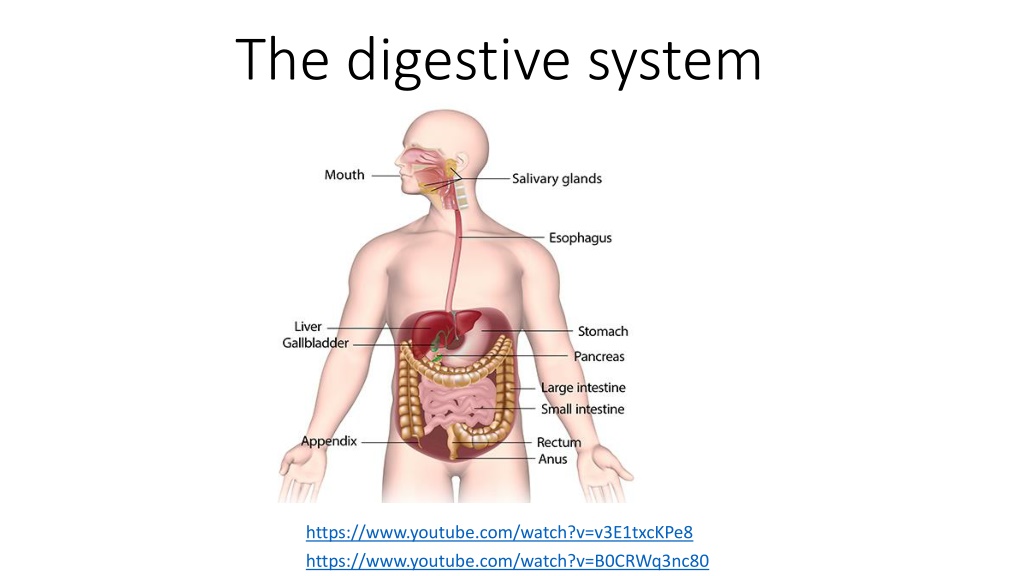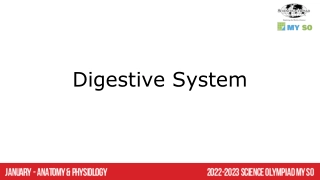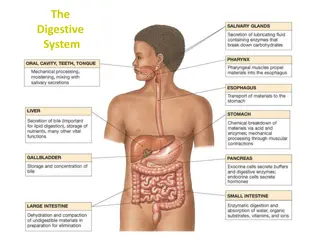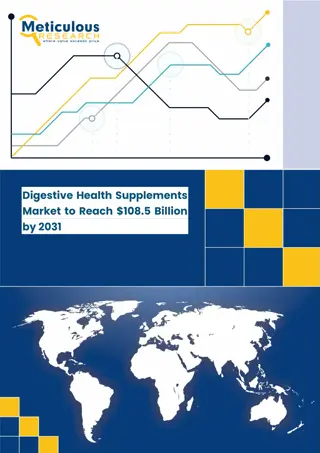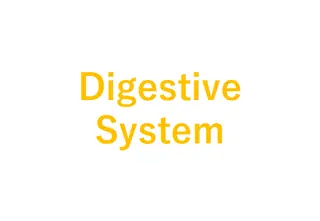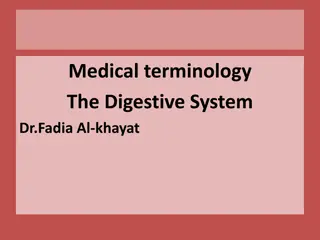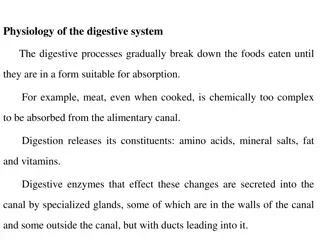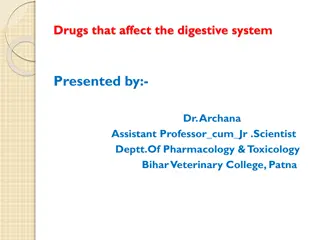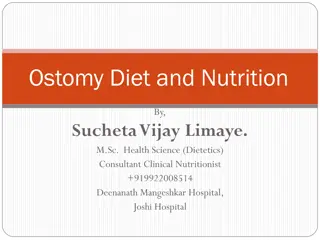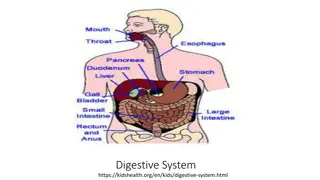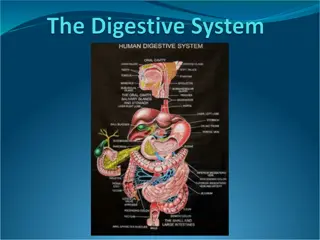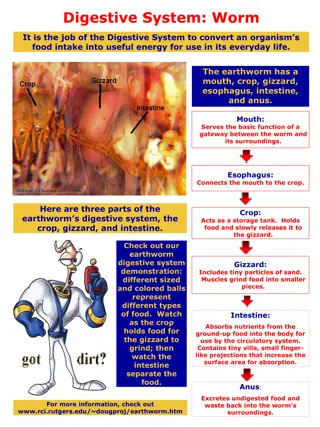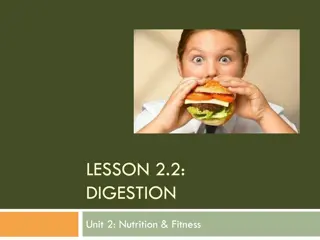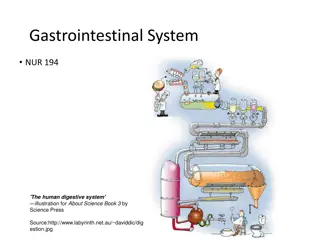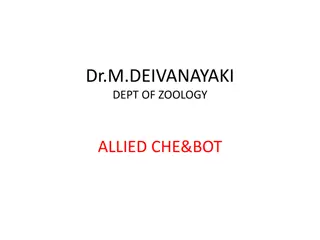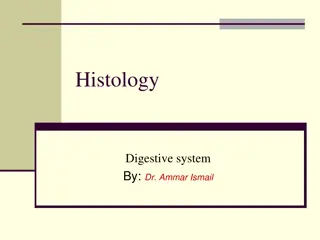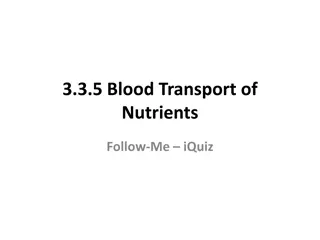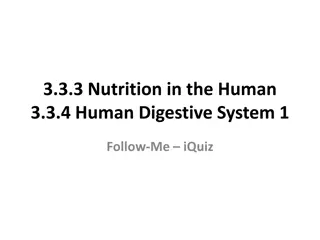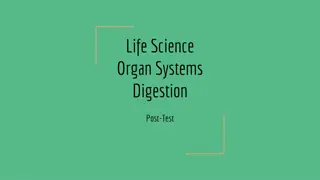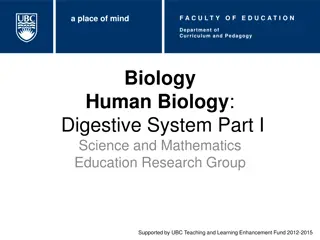Understanding the Digestive System and Its Processes
The digestive system plays a crucial role in breaking down food into nutrients for energy and growth. It involves various organs like the mouth, esophagus, stomach, small intestine, and large intestine, each with specific functions. Food moves through the digestive tract via mechanical and chemical digestion processes. Essential enzymes and acids aid in the breakdown of food particles for absorption into the bloodstream. Additionally, accessory organs and glands contribute to the overall digestive process.
Download Presentation

Please find below an Image/Link to download the presentation.
The content on the website is provided AS IS for your information and personal use only. It may not be sold, licensed, or shared on other websites without obtaining consent from the author. Download presentation by click this link. If you encounter any issues during the download, it is possible that the publisher has removed the file from their server.
E N D
Presentation Transcript
The digestive system https://www.youtube.com/watch?v=v3E1txcKPe8 https://www.youtube.com/watch?v=B0CRWq3nc80
What is digestion ? What is digestion ? It is the break down of food into smaller molecules and nutrients needed to be used for energy, growth, and cell repair.
How does food move through the digestive system? How does food move through the digestive system? The digestive tract (or the alimentary canal) is a long twisting tube through which the food goes down to our system. It starts at the mouth going through the pharynx, esophagus, stomach, small intestines, large intestines, rectum and anus. The food particles get digested in every stage of the alimentary canal as they move.
Mouth Types of Digestion Types of Digestion Mechanical (physical) - your teeth rip, break and crush food particles. Chemical saliva contains enzymes that break down food molecules and makes it slippery mass of food that will slide down easier.
Esophagus Moves food from the throat to the stomach using muscle movement called peristalsis. If acid from the stomach gets in here that s heartburn.
Stomach J-shaped muscular bag that stores the food you eat, breaks it down into tiny pieces. Mixes food with Digestive Juices that contain enzymes to break down Proteins and Lipids. Acid (HCl) in the stomach Kills Bacteria. Food found in the stomach is called Chyme.
Small Intestine Small intestines are roughly 7 meters long. Nutrients from the food pass into the bloodstream through the small intestine walls. Secretes digestive enzymes.
Large Intestine About 1.5 meters long. Accepts what small intestines don t absorb. Absorbs water into the bloodstream. Includes the Rectum, which is the last segment of the large intestine and serves as short term storage by holding the feces until it can expelled.
Accessory Organs / The Glands Not part of the path of food, but play a critical role. Include: Liver, gall bladder, and pancreas Bile helps digest fat digest fats, carbohydrates and proteins
Write the name of each colored organ: Green: Red: Pink: Brown: Purple: Dark green: Yellow:
How did you do? Green: Esophagus Red: Stomach Pink: Small Intestine Brown: Large Intestine Purple: Liver Dark green: Gall Bladder Yellow: Pancreas
Questions 1. Explain why most foods need to be digested. 2. Describe the route fibre takes through your body when you eat it. 3. Explain the difference between mechanical digestion and chemical digestion. 4. When your mouth 'waters' it makes saliva. Give two reasons why you need saliva. 5. What happens to food in your stomach? 6. Describe the two main processes that happen in your small intestine. 7. How do small food molecules such as glucose get from your alimentary canal (gut) to your cells?
Questions 1. Explain why most foods need to be digested. Digestion breaks large molecules down into smaller molecules that can be absorbed by the small intestine to the blood . 2. Describe the route fiber takes through your body when you eat it. mouth ------ esophagus ------ stomach -----duodenum----- small intestine ------ large intestine -------rectum ----- anus 3. Explain the difference between mechanical digestion and chemical digestion. Mechanical digestion to cut solid food into smaller pieces . Chemical digestion uses enzymes to break large food molecules into smaller ones .
Questions 4. When your mouth 'waters' it makes saliva. Give two reasons why you need saliva. Saliva contains an enzyme that begins the breakdown of starch. It also makes food slippery and soft so it is easier to swallow. 5. What happens to food in your stomach? It mixes with protease enzyme to digest protein in the presence of hydrochloric acid , hydrochloric acid also kills microbes .
Questions 6. Describe the two main processes that happen in your small intestine. Most large molecules are digested in the small intestine using enzymes. These small molecules are absorbed into the bloodstream. 7. How do small food molecules such as glucose get from your alimentary canal (gut) to your cells? Small food molecules are absorbed by the walls of the small intestine and pass into the blood. The blood carries them to cells all over the body
Questions 8. Decide whether statements a-f refer to mechanical digestion, chemical digestion or both. a) Digestion begins in our mouth. b) Teeth chew food to break up large pieces. c) Chewing increases the surface area of solid foods. d) Enzymes help large molecules to break down. e) Digestion ends in your small intestine.
Questions 8. Decide whether statements a-e refer to mechanical digestion, chemical digestion or both. a) Digestion begins in our mouth. both b) Teeth chew food to break up large pieces. mechanical c) Chewing increases the surface area of solid foods. mechanical d) Enzymes help large molecules to break down. Chemical e) Digestion ends in your small intestine. Chemical
Live worksheet- https://www.liveworksheets.com/worksheets/en/Natural_Science/Di gestive_system/The_digestive_system_qm1349010jv
